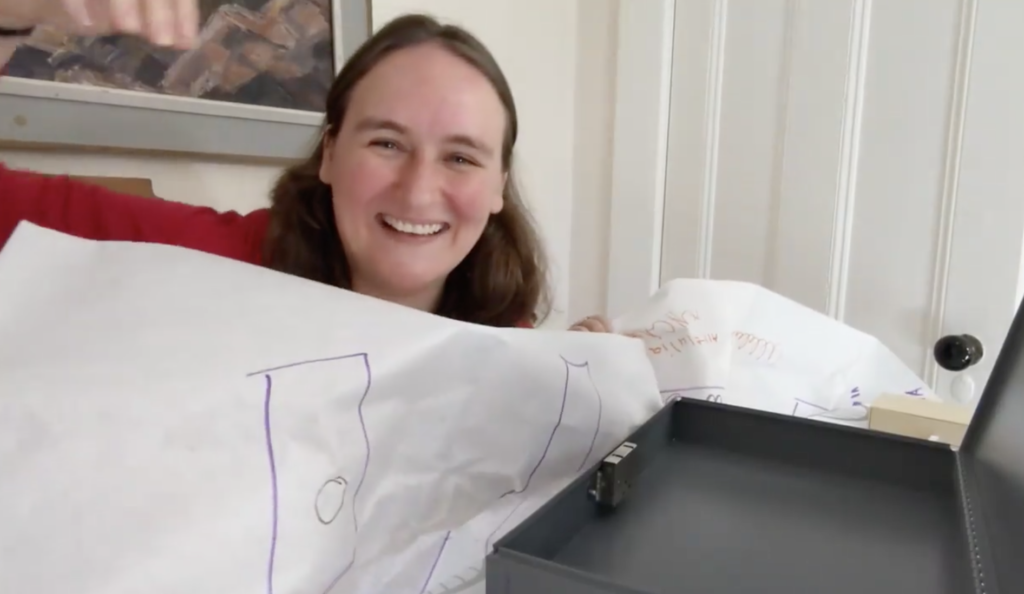Serving Stressed Families Online
Student, alum reflect on youth and children’s ministry during lockdown

By the Rev. Kyle Oliver
“It’s been difficult to figure out what it means to be a priest these days,” said the Rev. Maria (Mia) Kano ‘19, reflecting on the strange turn taken in her duties as assistant rector at St. Andrew’s Episcopal Church in Wellesley, MA.
Like counterparts in youth and family ministry at countless churches, Kano has been grappling with practical and theological questions about how to adapt to the limitations of COVID-19 lockdown.
She initially focused on providing continuity of connection.
“We were scheduled to have a board game night, so I decided I was going to figure out how we could still do that online,” said Kano. “I actually spent a lot of time playing around with Zoom and Steam, trying different games.”
Among the college friends and seminary classmates she recruited for her impromptu play testing was Ethan Lowery ‘20, who in addition to his studies at CDSP serves as youth minister at St. Stephen’s Episcopal Church in Orinda, CA.
Kano and Lowery have since leveraged the digital skills and interests of many of the young people they serve, hosting Pictionary-like games via the Zoom whiteboard and working with youth to lead online worship and create digital devotionals.

Kano is also offering video-based programming for a “one room schoolhouse” of the congregation’s children on Sunday mornings. Lowery has responded to the crisis, in part, with “more posts in general” on the congregation’s social media feeds, including a new emphasis on video and more interactive stories and discussion prompts on Instagram.
“As a youth minister, I’ve already had to confront how I feel about YouTube and phones and Fortnight and Minecraft, because those things are all centered in the life of this ministry and my youth,” Lowery said. “But now they feel ever more real and present. They’re not just in the room with us. They are the room itself.”
Coping with the effects of isolation
Kano has learned that the people she serves have a complex relationship with what happens in these ubiquitous digital rooms and that she needs to focus on “inviting them to serve as ministers” rather than simply “telling them to perform.”
Kano first organized a playful digital procession for Palm Sunday that was fun for young and old alike.
“Everyone had a turn to shout hosanna and run around the room they were in,” she said. “I showed it in our Zoom coffee hour to older parishioners who really miss seeing and interacting with kids. That felt really special to them.”
Wanting to build on this positive experience, she later invited young people to participate in a video-based Easter message for the parish. She received feedback from parents about the emotional dissonance between the message of Easter joy and the way many children are actually feeling.
The experience led her to explore options for proclaiming the gospel that avoided exacerbating young people’s “video fatigue.”

“Making collaborative art can be a way to make us feel like we’re together, but without the pressure of having to talk on camera,” Kano said. “Even if you don’t want to talk, you’re still together doing something as a community.”
Lowery points out that the effects of social isolation offer a simple but significant theological lesson about why churches are important in the first place.
“We use a lot of big words about communion and gathering that have, for some, felt esoteric up until this point,” he said. “Now that we can’t do them, they don’t feel esoteric anymore. We’re literally talking about being together. It’s not an abstract idea.”
He said these struggles during the lockdown can also help us reexamine stereotypes about youth and their relationship with media. “They love Minecraft, but when Minecraft is the only way that they get to hang out with their friends, it’s not enough for them. They miss the in-person time, too.”
It’s not just young people who are struggling, of course. Lowery and Kano both identified that, while children’s and youth ministry have always involved a degree of caring for parents, that part of their job has become much more pronounced.
“Everybody’s pastoral needs have shifted, and we’re learning how to meet them. Parents, in particular, are exhausted,” she said. And when parents are also ministry volunteers, the problem is compounded.
“It’s harder to focus on the needs of kids outside of their own family. The ask of ‘show up and volunteer for these other kids’ is even harder. This has been a good reminder of the importance of recruiting volunteers who aren’t parents.”
Lessons in faithful innovation
Despite the challenges, both leaders are optimistic about using this time to identify new forms of ministry and connect churches with people who don’t have strong past connections to their churches.
“Our mission field is a little bit scrambled,” Lowery said. “We all still have responsibilities to the churches and people that we serve, but now those offerings are available to more people … The question that’s been moved back to the center is ‘Is it possible to build new relationships?’ I think so.”
Kano attributes the impulse to continue looking onward and outward to the culture of formation she experienced at CDSP.
“We spent three years thinking about how to be innovative and evangelistic,” she said. “Learning what church looks like in experimental mode and how that’s an expression of God’s call to us: CDSP taught me that.”
Both Lowery and Kano had advice for discerning fruitful approaches to youth ministry in that mode.
Because Lowery already works on a parish staff, his CDSP field placement is with the Bay Area community organizing group Genesis. He says his experience there has guided his decision making about what kinds of opportunities to offer to St. Stephen’s youth and their families.
“The community organizing posture is that any movement or project you decide to undertake is the common decision of a group of people,” he said. “You make those calls not as the leader who knows better or more but as the democratic expression of the needs and longings of the people with whom you minister. So I have to return to those basics and text and call my parishioners. That’s always the starting place.”
In addition to responding to members of the community a leader serves, Kano stresses the kind of peer-to-peer sharing among leaders that brought her and Lowery together to try out online games for youth group.
“My diocese is now collaborating more than we ever have before,” Kano said. “The youth ministers and the children’s formation ministers are meeting biweekly. Churches are sharing materials, sharing things they’ve learned, sharing resources way more freely and joyfully and gratefully than I think they ever have.”
Here too, she said, her formation was important.
“Seminary is a place where you have to collaborate, where you learn to collaborate. Coming right from that, it’s felt natural to encourage all this working together.”
Kyle Oliver is communications & marketing manager and adjunct instructor in Christian education at Church Divinity School of the Pacific.

